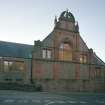Forfar, Chapel Street, Carnegie Baths
Baths (20th Century), Swimming Pool (20th Century)
Site Name Forfar, Chapel Street, Carnegie Baths
Classification Baths (20th Century), Swimming Pool (20th Century)
Alternative Name(s) Forfar Swimming Pool
Canmore ID 142486
Site Number NO45SE 150
NGR NO 4563 5054
Datum OSGB36 - NGR
Permalink http://canmore.org.uk/site/142486
- Council Angus
- Parish Forfar
- Former Region Tayside
- Former District Angus
- Former County Angus
Roughly 2-storey, irregular plan, Jacobean Renaissance public baths on steeply sloping site; 3-bay gable to NE (street) elevation with semicircular pediment with apex broken by pinnacle. Squared and snecked rubble masonry with red sandstone ashlar dressings; some brick elevations. Stone mullions. Predominantly shouldered gables.
Good example of public baths by an eminent architect. The building retains some interesting original fixtures and fittings including the glazed ceramic spittoons to the pool. The Jacobean Renaissance stonework detailing, particularly its gable, make a significant contribution to the streetscape. The baths were gifted to the town by the industrialist and philanthropist Andrew Carnegie (1835 - 1919), who attended the official opening of the facility on October 4, 1910. As well as a public swimming pool, the rear section of the building originally contained bath tubs for public cleanliness, as at this time many modest homes still did not have a bathroom.
Swimming clubs and bath houses were established in Scotland from the 1850s following the enactment of the 1846 Act to Encourage the Establishment of Public Baths and Wash-houses, which was established to improve general public health with access for all classes of citizen. With the rapid expansion of urban population, often living and working in unsanitary conditions, bath and wash houses were seen as essential public services. The Act, which affected the entirety of Britain, encouraged local authorities to open up these facilities in areas of dense population. These bath and wash houses soon started to cater for recreational swimming rather than washing and became a hugely popular social past time during the 20th century.
Hippolyte Jean Blanc (1844-1917) was an eminent and prolific Edinburgh based architect who was perhaps best known for his Gothic revival churches. He was also a keen antiquarian and many of his buildings evoke an earlier Scottish style. The building was extended by the Burgh Surveyor, A Waterston. (Historic Environment Scotland List Entry)
















